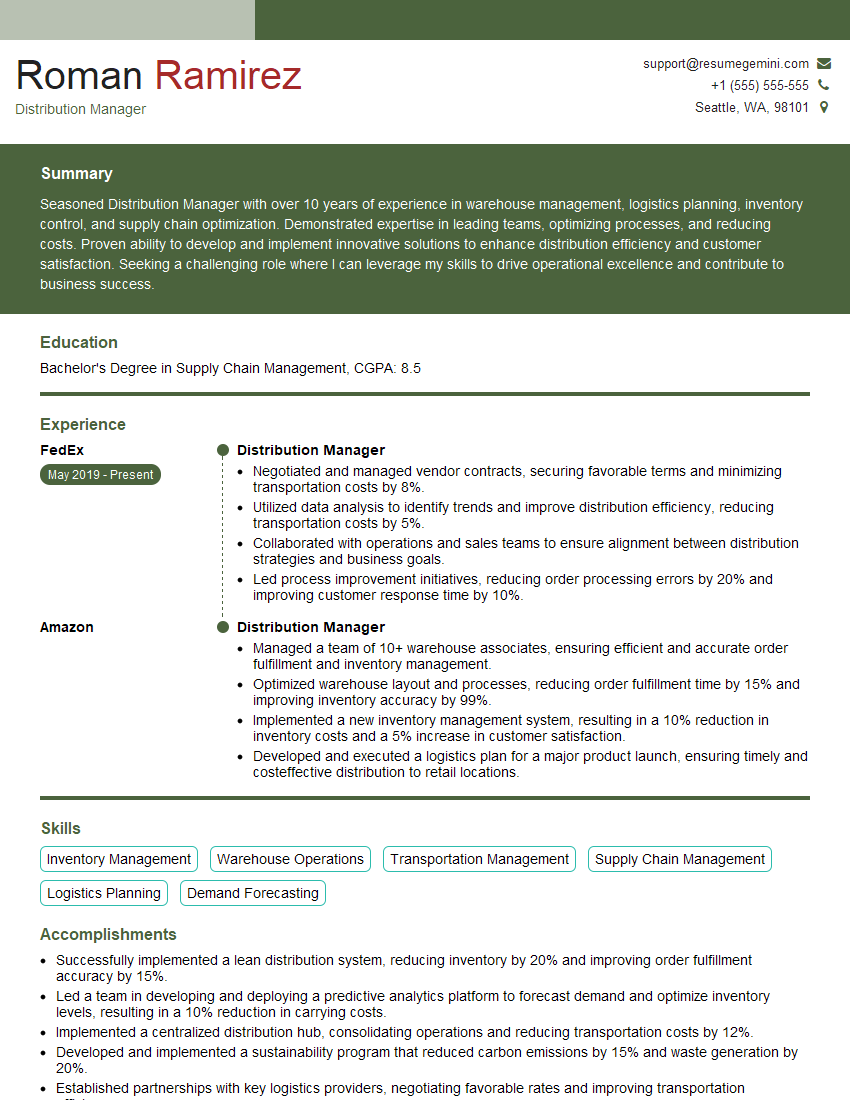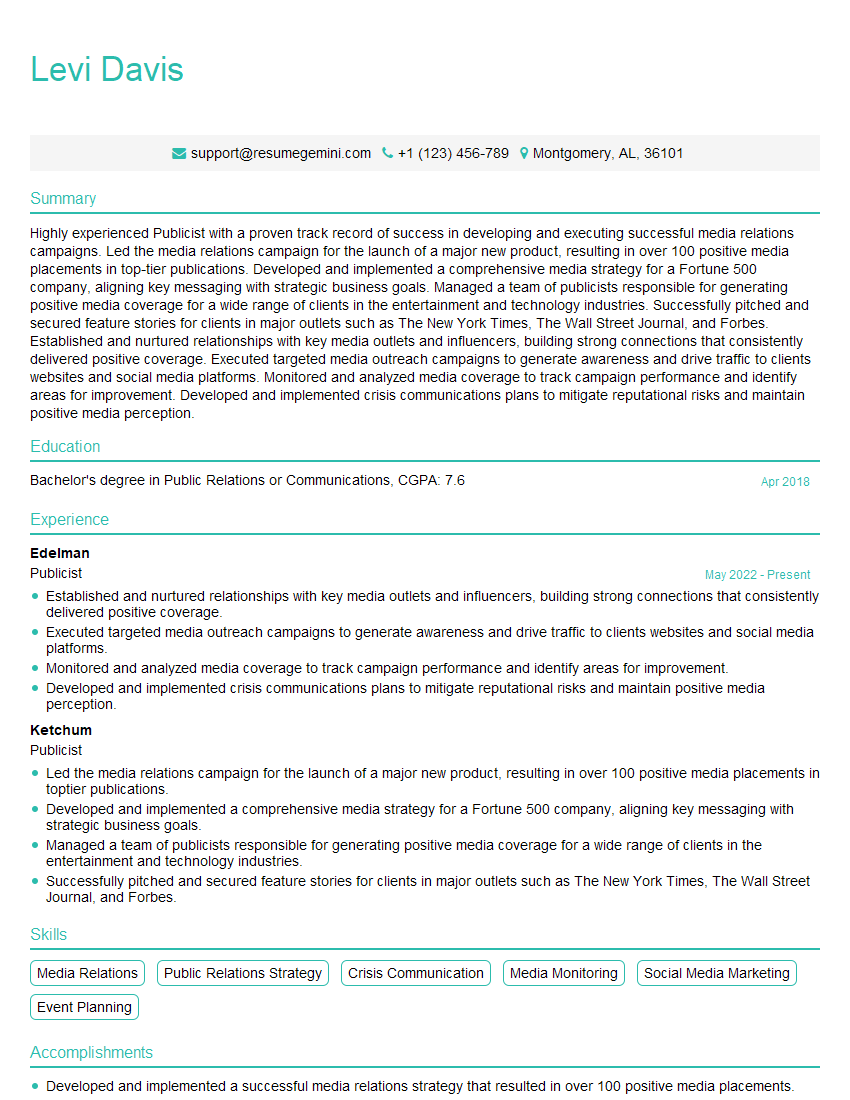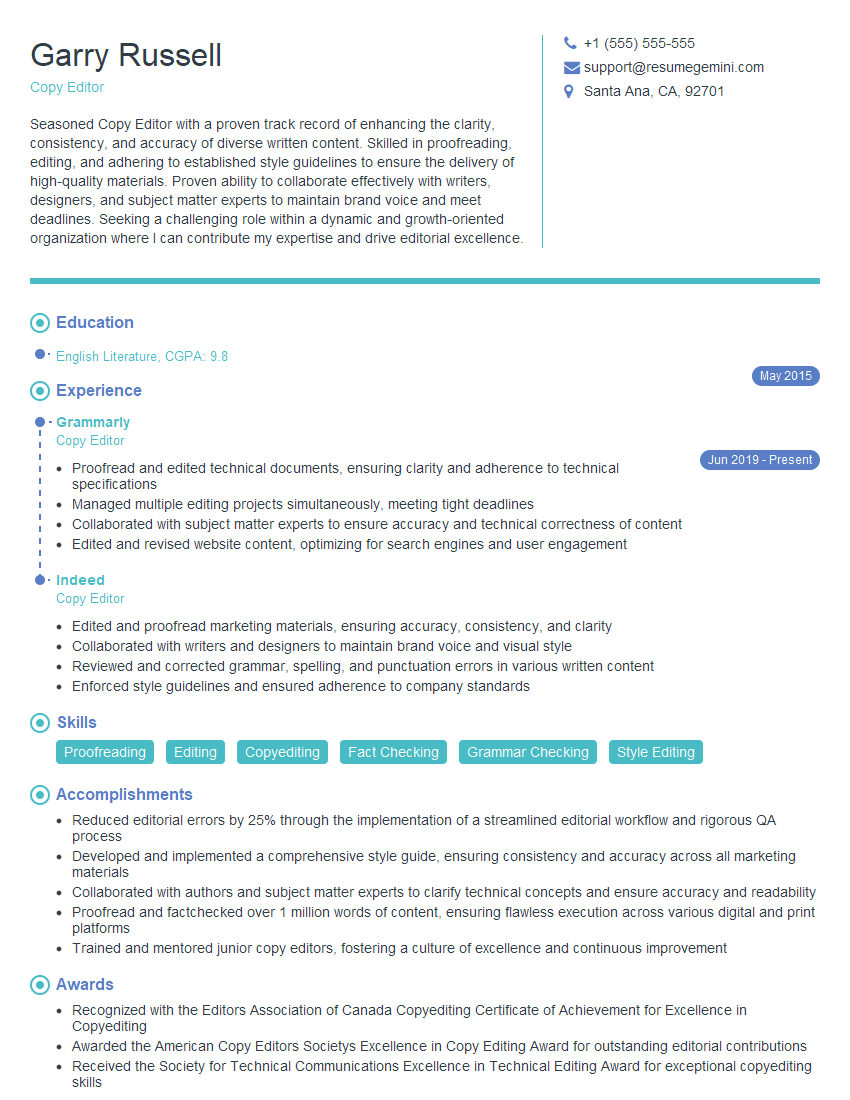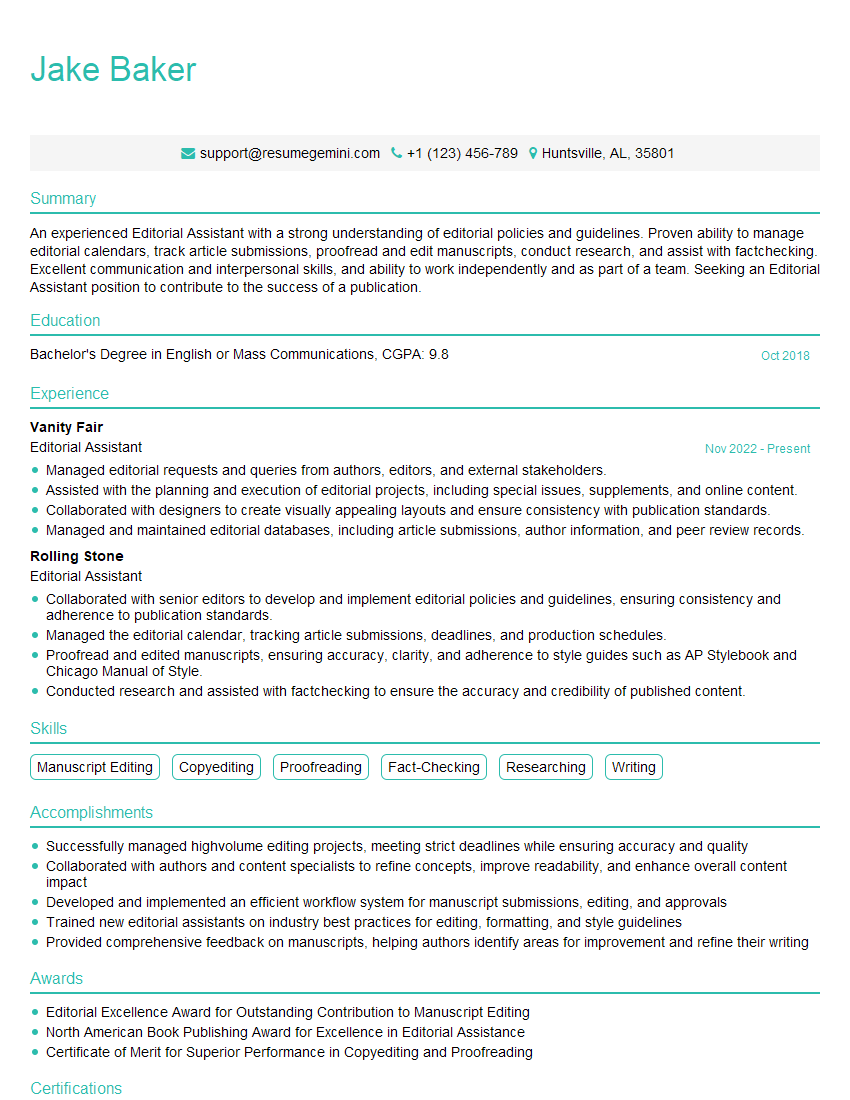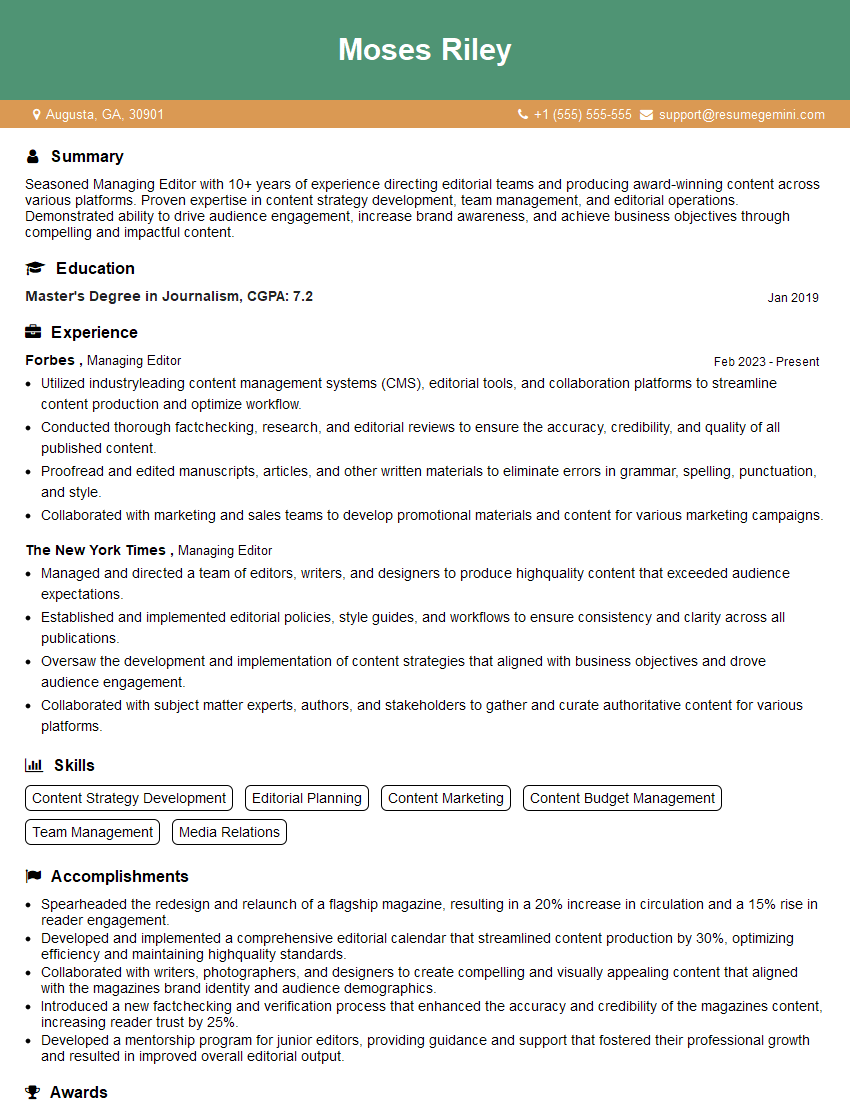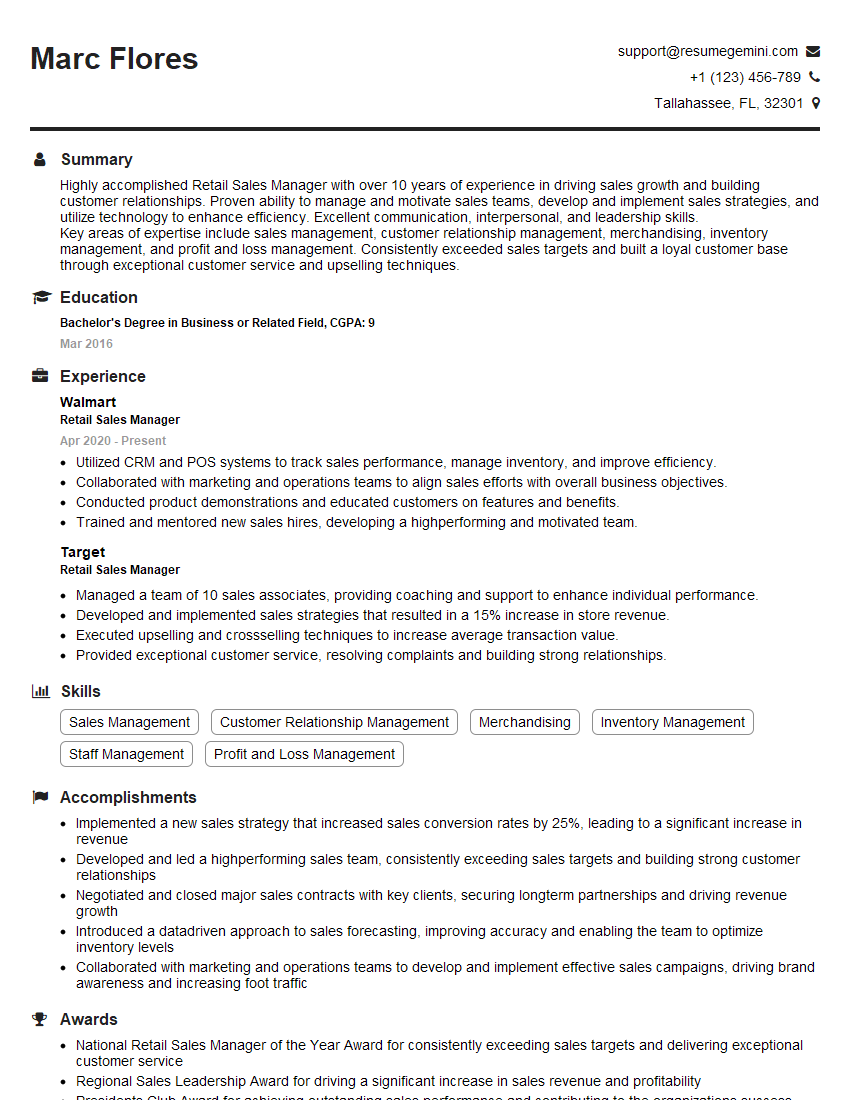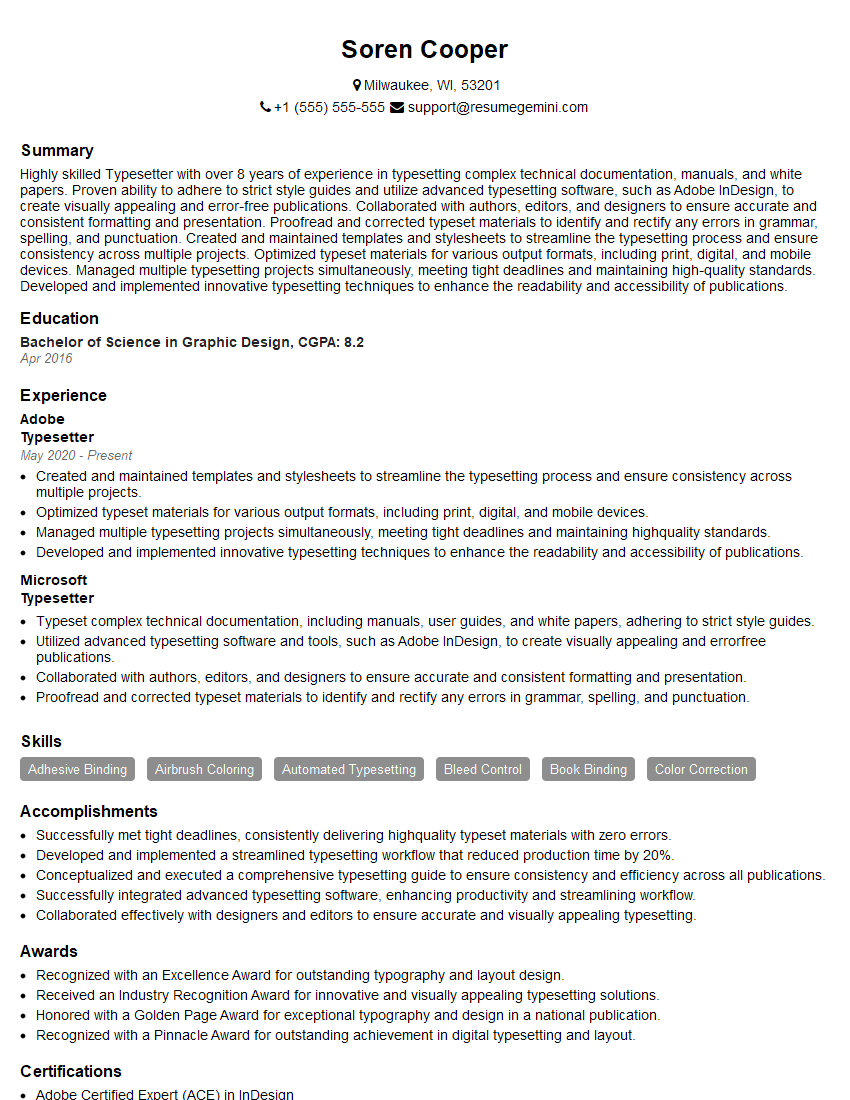Feeling uncertain about what to expect in your upcoming interview? We’ve got you covered! This blog highlights the most important Publishing and Distribution interview questions and provides actionable advice to help you stand out as the ideal candidate. Let’s pave the way for your success.
Questions Asked in Publishing and Distribution Interview
Q 1. Explain the difference between print and digital distribution channels.
Print and digital distribution channels differ fundamentally in their methods and reach. Print distribution relies on physical copies of books, magazines, or other publications, involving printing, warehousing, shipping, and retail partnerships. This traditional route reaches readers through bookstores, libraries, wholesalers, and direct mail. Digital distribution, on the other hand, involves electronic formats like ebooks, audiobooks, and online journals, accessed through platforms such as Amazon Kindle, Apple Books, or dedicated publishing websites. This method utilizes internet infrastructure, eliminating the need for physical shipping but requiring robust online platforms and digital rights management (DRM) systems.
Think of it like this: print is like sending a physical postcard – tangible and slow but with a certain charm. Digital is like sending an email – instant, global, and cost-effective, but less tactile. Each method serves a different audience and has unique cost structures and challenges.
- Print: Higher upfront costs (printing, binding, shipping), slower distribution, geographical limitations, but potentially higher profit margins per unit.
- Digital: Lower upfront costs, instant global reach, wider audience, scalable distribution, but potentially lower profit margins per unit due to competition and pricing pressures.
Q 2. Describe your experience with managing inventory in a publishing or distribution setting.
My experience managing inventory spans over ten years, encompassing both print and digital titles. In a print environment, I utilized inventory management software to track stock levels, predict demand based on sales data and seasonal trends, and manage the ordering and replenishment process from printers and warehouses. We employed a Just-in-Time (JIT) inventory system to minimize storage costs while ensuring sufficient stock for peak demand periods. This involved careful forecasting, analyzing sales data from previous years and current trends, and collaborating closely with our printing partners to adjust print runs as needed. For digital titles, inventory management focuses on ensuring sufficient server capacity and bandwidth to handle peak user traffic and prevent website crashes. Regular monitoring of storage space, update deployments, and digital rights management (DRM) systems are also crucial.
For example, during the holiday season, we would anticipate a surge in demand for children’s books. We’d increase our inventory levels accordingly, working with our printers to schedule additional print runs well in advance. A major challenge was predicting demand accurately, as unforeseen bestsellers or unexpected slowdowns in sales could leave us overstocked or understocked.
Q 3. How do you handle supply chain disruptions in the publishing industry?
Supply chain disruptions, such as paper shortages, printing plant closures, or shipping delays, are significant concerns. My approach involves a multi-pronged strategy:
- Diversification of Suppliers: We avoid relying on a single supplier for any key component. Multiple printing partners and paper suppliers ensure resilience against disruptions.
- Strategic Inventory Management: Maintaining a buffer stock of key materials allows us to absorb minor disruptions without significant delays. This requires accurate forecasting and a close relationship with suppliers.
- Flexible Production Plans: We prioritize agility in production, quickly adjusting print runs and distribution plans based on real-time information. This often involves exploring alternative printing methods or distribution channels if needed.
- Open Communication: Maintaining transparent and proactive communication with authors, distributors, and customers keeps everyone informed and minimizes potential negative impacts.
- Contingency Planning: Having detailed plans to address potential disruptions, including alternative printing locations and transportation routes.
For instance, during the pandemic, we faced significant paper shortages. We proactively contacted alternative suppliers, negotiated higher prices to secure supplies, and communicated the potential delays to our authors and distributors, managing expectations and avoiding surprises.
Q 4. What metrics do you use to measure the success of a publishing campaign?
Measuring the success of a publishing campaign relies on a blend of quantitative and qualitative metrics. Key quantitative metrics include:
- Sales figures: Units sold, revenue generated, market share achieved.
- Return on Investment (ROI): A crucial indicator comparing total costs with total revenue.
- Website traffic and engagement: Unique visitors, page views, time spent on site, conversion rates.
- Social media engagement: Reach, likes, shares, comments, brand mentions.
- Reviews and ratings: Reflecting reader satisfaction and influencing future sales.
Qualitative metrics provide deeper insights:
- Reader feedback: Reviews, comments, social media interactions.
- Brand awareness and perception: Surveys and focus groups.
- Media coverage and critical acclaim: Positive reviews from book critics and media exposure influence sales and perceptions.
A comprehensive analysis of these metrics helps assess the overall success and identify areas for improvement in future campaigns.
Q 5. What is your experience with copyright and licensing agreements?
I have extensive experience negotiating and managing copyright and licensing agreements. This involves understanding the nuances of copyright law, including author rights, publisher rights, and the various types of licenses (e.g., exclusive, non-exclusive, subsidiary rights). I’m adept at drafting and reviewing contracts, ensuring that they are legally sound and protect the interests of all parties involved. My experience includes negotiating rights for translations, adaptations, film and television options, and other subsidiary rights. I have successfully navigated complex situations involving multiple rights holders and international collaborations. A key aspect of this work is building and maintaining strong relationships with authors, agents, and other rights holders, facilitating effective communication and collaborative problem-solving.
For instance, I once successfully negotiated a complex licensing agreement for a successful novel that involved securing subsidiary rights for a foreign language translation, an audiobook version, and a film adaptation. It required meticulous attention to detail and a strong understanding of intellectual property law to ensure that the terms were fair and beneficial to both the author and the publishing company.
Q 6. How familiar are you with different printing techniques and their cost implications?
My knowledge of printing techniques encompasses offset printing, digital printing, on-demand printing, and various binding methods. Offset printing is cost-effective for large print runs but involves higher setup costs. Digital printing is ideal for smaller runs and allows for greater flexibility and customization, but the unit cost is often higher. On-demand printing is perfect for very small runs or niche publications, allowing for the printing of books only when orders are received. Each technique has different cost implications based on factors like run length, paper type, color complexity, and binding requirements.
I’ve successfully managed projects utilizing all these techniques, selecting the most cost-effective option based on the project’s specific needs. For instance, a mass-market paperback would benefit from offset printing due to its low unit cost at high volumes. A limited edition art book, conversely, would be better suited to digital printing, allowing for high-quality color reproduction and customization.
Q 7. Describe your experience with contract negotiations with authors or distributors.
Negotiating contracts with authors and distributors requires strong communication, legal expertise, and a deep understanding of the publishing industry’s business models. I have extensive experience in negotiating author contracts, covering issues such as advances, royalties, rights, and deadlines. With distributors, negotiations involve terms of sale, discounts, payment schedules, and returns policies. The key is to build mutually beneficial relationships based on trust and transparency.
For example, when negotiating an author contract, I focus on building a collaborative relationship by understanding their career goals and aspirations. This enables me to offer a fair deal that acknowledges their value while protecting the publisher’s interests. With distributors, effective negotiations involve understanding their logistical capabilities and market reach. The goal is to secure a mutually beneficial agreement that optimizes distribution and maximizes the book’s reach and sales potential.
Q 8. Explain your understanding of ISBNs and their role in book distribution.
An ISBN, or International Standard Book Number, is a unique 13-digit identifier assigned to each edition and variation of a book. Think of it as a book’s fingerprint – it’s crucial for tracking and identifying it throughout the entire publishing and distribution process. It’s not just about identifying a title; it differentiates between hardcovers, paperbacks, different editions (e.g., first edition vs. revised edition), and even different formats (e.g., ebook, audiobook).
In book distribution, the ISBN acts as the key to efficient inventory management, sales tracking, and supply chain logistics. Booksellers, distributors, and libraries use ISBNs to order, categorize, and manage their stock. It’s the fundamental code that allows systems to seamlessly track a book’s journey from publisher to reader. Without ISBNs, tracking sales, managing inventory, and preventing counterfeiting would be a logistical nightmare.
For example, a specific hardcover edition of a novel might have one ISBN, while the paperback version of the same book would have a different ISBN. This allows publishers and retailers to accurately track sales and inventory for each specific format.
Q 9. How do you analyze sales data to inform future publishing decisions?
Analyzing sales data is crucial for making informed publishing decisions. It’s not just about looking at the total number of books sold; it’s about understanding the why behind the numbers. I typically employ a multi-faceted approach.
- Identifying Trends: I start by examining sales data over time, looking for trends in sales velocity, seasonal peaks and troughs, and regional variations. This helps to understand the book’s overall performance and potential longevity.
- Analyzing Demographics: We dissect sales data to understand the demographic profile of our readers – age, location, gender, purchasing habits. This informs future marketing and publicity efforts, allowing us to better target specific groups.
- Channel Analysis: Understanding sales performance across different channels (Amazon, bookstores, online retailers) is crucial. This helps identify the most successful channels and inform future distribution strategies. For example, if a book performs exceptionally well on Amazon but poorly in physical bookstores, it may indicate a need for adjustments to the marketing or distribution strategy.
- Competitive Analysis: We compare our book’s sales to similar titles in the market to gauge its competitiveness and identify opportunities for improvement.
This comprehensive analysis helps to inform decisions about future projects, reprint runs, marketing campaigns, and even the genre or themes of future acquisitions. For instance, if a particular sub-genre within a category consistently outperforms others, we might prioritize acquiring manuscripts within that sub-genre.
Q 10. What strategies do you employ to reach specific target audiences?
Reaching specific target audiences requires a nuanced understanding of their preferences and behaviors. We use a multi-pronged approach, tailoring our strategies to the specific demographics of the book’s readership.
- Targeted Advertising: Online advertising platforms allow us to target specific demographics based on age, interests, location, and reading habits. We might use platforms like Facebook, Instagram, and Google Ads to reach specific groups.
- Strategic Partnerships: Collaborating with influencers, bloggers, and relevant organizations helps expand reach within the target audience. For instance, if the book focuses on a particular hobby, partnering with a relevant community forum or online group can be effective.
- Content Marketing: Creating valuable content – blog posts, articles, videos – that resonates with the target audience generates interest and builds brand awareness. This content can be strategically placed on relevant platforms to reach the right people.
- Public Relations: Press releases and media outreach to publications that cater to the specific demographic helps build credibility and generate buzz.
For example, a young adult novel might utilize influencer marketing on platforms like TikTok and Instagram, while a professional development book might focus on targeted LinkedIn advertising and partnerships with industry organizations. A crucial component is constant A/B testing of different strategies to optimize campaigns and reach the maximum impact.
Q 11. How would you handle a situation where a book’s sales are significantly below projections?
When a book’s sales fall significantly below projections, a systematic investigation is vital. It’s not about assigning blame, but about understanding the reasons and implementing corrective actions.
- Analyze Sales Data: Thoroughly examine sales data to identify any specific patterns. Are sales low across all channels, or only in certain regions or platforms? Are there any obvious factors that might contribute to the poor performance (e.g., poor reviews, lack of marketing effort, strong competition)?
- Review Marketing and Publicity: Assess the effectiveness of the marketing and publicity campaign. Were the target audiences properly identified and reached? Was the marketing messaging effective? Did the book’s positioning in the market accurately reflect its contents?
- Investigate Customer Feedback: Gather customer reviews, feedback, and comments to identify any concerns or issues with the book itself or the marketing. Are there any common negative themes or criticisms that need to be addressed?
- Explore Pricing and Availability: Evaluate the book’s pricing and availability across different channels. Is the book priced competitively? Are there any distribution issues affecting availability?
- Implement Corrective Actions: Based on the findings from the analysis, implement corrective actions. This might involve adjustments to the marketing strategy, price adjustments, improved distribution channels, or even targeted campaigns to counter negative reviews.
It’s crucial to remember that not every book will be a bestseller. A thorough investigation and proactive response, however, can minimize losses and provide valuable lessons for future projects.
Q 12. Describe your experience with marketing and publicity strategies for books.
My experience with marketing and publicity encompasses a wide range of strategies, always tailored to the individual book and its target audience.
- Pre-publication Buzz: Generating excitement before the launch is crucial. This might involve early reviews, excerpts in relevant publications, author interviews, and targeted social media campaigns.
- Author Platform Building: Helping authors develop and leverage their online presence – building a website, engaging on social media, and participating in relevant online communities – increases visibility and fosters direct engagement with readers.
- Media Outreach: Reaching out to journalists, bloggers, and reviewers in relevant publications is crucial for getting the book reviewed and featured. This is done through targeted press releases and media kits.
- Advertising Campaigns: Utilizing various advertising platforms (online, print, radio) to reach specific target audiences.
- Events and Book Tours: Organizing or participating in book signings, literary festivals, and book tours to engage directly with potential readers and create a sense of community around the book.
- Email Marketing: Building an email list and sending targeted newsletters to keep readers updated on new releases and author news.
The success of a marketing campaign depends on data analysis, adaptability, and a deep understanding of the book’s unique attributes and its potential readership. For instance, a historical fiction novel might benefit from a strong emphasis on traditional media outreach, while a self-help book might thrive with online advertising and influencer marketing.
Q 13. How familiar are you with various distribution platforms (e.g., Amazon, Ingram)?
I’m highly familiar with various distribution platforms, recognizing that each has its own strengths and weaknesses.
- Amazon: A dominant force in book sales, offering extensive reach but also high competition and demanding optimization strategies. Understanding Amazon’s algorithms and best practices is critical for success on this platform.
- IngramSpark/Ingram Publisher Services: These platforms provide crucial access to a wide network of bookstores and libraries, both physical and online. They’re invaluable for reaching a broader audience beyond just Amazon.
- Barnes & Noble: A significant player in the US market, requiring a separate distribution strategy to maximize sales.
- Independent Bookstores: Working directly with independent bookstores fosters stronger relationships and can create opportunities for targeted marketing and author events.
Understanding each platform’s unique requirements – such as metadata standards, file formats, and distribution terms – is critical for maximizing reach and sales. The selection of distribution platforms depends on the book’s target audience, genre, and marketing strategy.
Q 14. What is your understanding of print-on-demand technology?
Print-on-demand (POD) is a revolutionary technology in book publishing, allowing publishers to print individual copies of a book only when ordered. This eliminates the need for large print runs and significantly reduces the risk of unsold inventory.
Benefits of POD:
- Reduced Risk: Publishers don’t need to invest heavily in upfront printing costs, minimizing financial risk.
- Inventory Management: There’s no need to store large quantities of books, saving on warehouse space and costs.
- Wider Range of Titles: Publishers can offer a more diverse catalog, as they’re not restricted by the costs of printing large quantities.
- Faster Turnaround Times: Books can be printed and shipped quickly, resulting in faster delivery times for customers.
Limitations of POD:
- Higher Per-Unit Costs: Individual printing typically costs more than mass printing.
- Less Control Over Print Quality: While quality is generally acceptable, POD may not match the quality of mass-produced books.
POD is a particularly useful technology for niche titles, self-published authors, and publishers who want to offer a wide range of books without significant financial risk. It’s a valuable tool in a modern publisher’s arsenal, offering flexibility and efficiency.
Q 15. How do you prioritize projects with competing deadlines?
Prioritizing projects with competing deadlines in publishing requires a structured approach. I use a combination of methods, starting with a clear understanding of each project’s scope, dependencies, and deadlines. I then utilize project management tools (more on that in the next answer) to visualize the workload and identify potential bottlenecks.
My prioritization framework considers several factors:
- Urgency: Projects with imminent deadlines naturally take precedence.
- Impact: High-impact projects, such as flagship titles or those with significant marketing budgets, get prioritized.
- Dependencies: Projects that are dependent on others are sequenced logically to avoid delays.
- Resource Allocation: I assess the availability of personnel and other resources to ensure realistic scheduling.
For example, if I have a high-impact novel with a close deadline and a smaller project with a later deadline, the novel would be prioritized. However, if the smaller project involves crucial work (like creating marketing assets) that the novel depends on, its deadline might need to be adjusted to support the higher priority project.
Career Expert Tips:
- Ace those interviews! Prepare effectively by reviewing the Top 50 Most Common Interview Questions on ResumeGemini.
- Navigate your job search with confidence! Explore a wide range of Career Tips on ResumeGemini. Learn about common challenges and recommendations to overcome them.
- Craft the perfect resume! Master the Art of Resume Writing with ResumeGemini’s guide. Showcase your unique qualifications and achievements effectively.
- Don’t miss out on holiday savings! Build your dream resume with ResumeGemini’s ATS optimized templates.
Q 16. Describe your experience with project management software relevant to publishing.
I have extensive experience with various project management software tailored to the publishing industry. My go-to tools include Asana and Trello for managing tasks, deadlines, and team collaboration. These platforms are fantastic for tracking the progress of multiple projects simultaneously, assigning tasks, and ensuring clear communication among editors, designers, production teams, and authors.
For example, in a recent project, we used Asana to manage the production of a complex textbook. Each chapter had its own task list, allowing the team to track edits, proofreading, design, and even the separate stages of the printing process. We used custom fields to tag things like ‘artwork needed’ or ‘index required’ which ensured nothing fell through the cracks. The timeline feature helped us maintain visual oversight, instantly showing any potential delays.
In addition, I’ve utilized specialized publishing software such as [mention specific software, if applicable, otherwise state a general approach] for manuscript tracking and handling the complexities of file formats involved in the printing and ebook production pipelines. This ensures seamless handoffs between different stages of the publishing process.
Q 17. What are some key challenges facing the publishing industry today?
The publishing industry faces numerous challenges in today’s digital landscape. Some key issues include:
- The rise of e-books and digital distribution: This has significantly altered the revenue models and distribution strategies of traditional publishers. It requires publishers to adapt to new platforms and reading habits.
- Increased competition from self-publishing: Self-publishing platforms offer authors more direct control, posing competition to traditional publishing houses.
- Maintaining profitability amidst rising costs: Printing, distribution, and marketing costs can be substantial.
- Copyright issues and piracy: Protecting intellectual property remains a major concern.
- Discovering and nurturing new talent: Finding and cultivating authors with commercially successful potential is an ongoing challenge.
- Adapting to changing reader preferences: Readers’ tastes and consumption patterns constantly evolve. Publishers must continually adapt to this.
The industry needs innovative solutions to overcome these obstacles, such as exploring new revenue streams, embracing digital technologies, and fostering collaborative partnerships to remain competitive and relevant.
Q 18. How do you stay up-to-date with industry trends and best practices?
Staying current in the dynamic publishing world is crucial. I employ a multi-pronged approach:
- Industry publications and journals: I regularly read publications like Publishers Weekly and The Bookseller to stay informed about trends, best practices, and emerging technologies.
- Conferences and workshops: Attending industry events provides valuable networking opportunities and exposure to the latest developments.
- Online resources and webinars: Many organizations offer webinars and online courses covering various aspects of publishing.
- Professional organizations: Membership in relevant professional bodies provides access to exclusive resources and networking opportunities.
- Mentorship and networking: Engaging with experienced professionals through mentorship or industry networks facilitates knowledge sharing and insights into industry dynamics.
This continuous learning allows me to anticipate future challenges and incorporate the latest strategies into my workflow.
Q 19. How would you manage a conflict between an author and the editorial team?
Conflicts between authors and editorial teams are unfortunately common. My approach emphasizes open communication, empathy, and a collaborative problem-solving approach. The goal is always to find a solution that respects the author’s vision while upholding editorial standards.
My strategy usually involves:
- Active listening: Understanding both the author’s perspective and the editorial team’s concerns is the first step.
- Facilitation: I would act as a mediator, ensuring a safe space for open dialogue.
- Compromise: Finding common ground involves proposing alternative solutions and exploring options that accommodate both sides’ needs.
- Documentation: Keeping a detailed record of discussions, decisions, and agreements helps prevent misunderstandings.
- Escalation if necessary: If the conflict cannot be resolved internally, I would escalate the issue to a senior editor or a designated conflict resolution officer.
Remember, preserving the author-publisher relationship is paramount. By fostering a culture of mutual respect and understanding, most conflicts can be resolved constructively.
Q 20. Explain your experience with different book formats (e.g., hardcover, paperback, ebook).
I have extensive experience with various book formats, understanding the nuances and production requirements of each. My experience encompasses:
- Hardcover: I understand the processes involved in selecting appropriate paper stock, binding techniques (case binding, perfect binding), and jacket design. I’m familiar with different cover finishes (dust jackets, embossing, etc.).
- Paperback: This involves knowledge of different paper types, printing methods (offset, digital), and binding (perfect binding, saddle stitch). I understand the trade-offs between print quality and cost.
- E-books: My expertise includes file formats (EPUB, MOBI, PDF), metadata creation, and optimizing books for different e-readers and platforms (Kindle, Kobo, Apple Books). I am familiar with the processes for ensuring text reflow and accessibility compliance.
Understanding the strengths and limitations of each format allows me to make informed decisions regarding production, pricing, and target market. For example, a high-quality art book might be best suited for hardcover, while a quick-read novel might be ideally suited for both paperback and ebook formats.
Q 21. How do you ensure the quality control of published materials?
Quality control is paramount. My approach to ensuring the quality of published materials is multi-layered and begins long before publication.
The process includes:
- Editorial review: This involves multiple stages of editing—developmental, copyediting, and proofreading—to ensure accuracy, clarity, and consistency.
- Design review: Thorough review of the layout, typography, and image quality to ensure visual appeal and readability.
- Proofreading: Careful review of the final files to catch any remaining errors before printing or publishing.
- Pre-flight checks: Using specialized software, I check the files for any technical issues or inconsistencies before they are sent to print or digital distribution.
- Print and digital testing: Testing print proofs and digital versions on various devices to ensure optimal viewing quality and functionality.
- Post-publication review: Monitoring reviews, feedback, and sales data to identify any potential issues or areas for improvement in subsequent editions.
This systematic approach minimizes errors and maximizes the quality of the final product, ensuring a positive reader experience.
Q 22. Describe your experience with international distribution.
My experience with international distribution spans over 15 years, encompassing various publishing formats – from print books and journals to ebooks and audiobooks. I’ve worked with distributors across North America, Europe, and Asia, navigating diverse cultural contexts, regulatory frameworks, and logistical hurdles. This involved selecting appropriate distribution partners based on their reach, expertise in specific markets, and alignment with our publishing house’s goals. For instance, when launching a new author in the Japanese market, we partnered with a local distributor with strong connections to bookstores and online platforms, which significantly boosted our sales compared to a more generic approach. A key aspect of this process is understanding local market dynamics, including language translation, cultural sensitivity, and pricing strategies. It’s not a one-size-fits-all approach; tailoring the distribution strategy to the unique characteristics of each target market is crucial.
Q 23. How do you optimize distribution channels for maximum reach?
Optimizing distribution channels requires a multifaceted approach that prioritizes data-driven decision-making and strategic partnerships. It starts with identifying your target audience and their preferred consumption methods. Are they primarily online readers, frequenting specific platforms like Amazon Kindle or Google Play? Or do they prefer physical bookstores and libraries? Once this is established, we can select the most effective channels. This might involve a blend of direct sales to large retailers, utilizing wholesale distributors for broader reach, and exploring digital distribution platforms for online access. We regularly assess the performance of each channel, using metrics like sales figures, return rates, and customer feedback to optimize our strategy. For example, if sales through a particular online platform are consistently low, we may explore alternative strategies like targeted advertising or revising our pricing model for that specific platform. Continuous monitoring and adaptation are essential for maximum reach.
Q 24. What are your strategies for building relationships with key stakeholders?
Building strong relationships with key stakeholders – including distributors, retailers, librarians, and even authors – is paramount in publishing. It’s about more than just transactional relationships; it’s about fostering trust and mutual benefit. This involves open communication, proactive collaboration, and a genuine commitment to understanding their needs and challenges. I regularly attend industry events and conferences to network and strengthen existing partnerships. We also host regular meetings and webinars to engage with our distributors, sharing sales data, marketing plans, and future publishing projects. Furthermore, offering excellent customer service and promptly addressing any issues that arise goes a long way in building and maintaining strong relationships. Think of it like building a bridge – it takes time, effort, and consistent maintenance, but the rewards are immeasurable in terms of long-term success and mutually beneficial collaboration.
Q 25. How do you use data analytics to improve distribution efficiency?
Data analytics plays a vital role in improving distribution efficiency. We utilize sales data, inventory levels, and customer feedback to track performance, identify trends, and make informed decisions. For example, by analyzing sales data across different regions, we can identify areas with high potential for growth or those requiring adjustments to our distribution strategy. Similarly, analyzing inventory levels helps optimize stock management, reducing storage costs and minimizing the risk of stockouts or overstocking. Tools like SQL and business intelligence software are instrumental in extracting insights from our data. We use dashboards to visualize key performance indicators (KPIs) and identify areas for improvement. A significant application is predictive analytics; by analyzing historical sales data and market trends, we can predict future demand and proactively adjust our distribution plans accordingly.
Q 26. Describe your experience with budget management in a publishing environment.
Budget management in publishing requires careful planning and meticulous tracking. It involves allocating resources effectively across different stages of the distribution process, including printing, warehousing, transportation, and marketing. We use budgeting software to create detailed budgets and track expenses against projections. This includes forecasting sales, estimating costs associated with different channels, and factoring in potential risks and contingencies. Regular budget reviews are conducted to ensure we are staying within allocated funds and making necessary adjustments as needed. Transparency and accountability are key elements in our budget management process, and we regularly report on budget performance to relevant stakeholders. A well-managed budget ensures financial stability and allows us to invest strategically in areas that drive growth and maximize return on investment.
Q 27. What is your approach to solving logistical challenges in distribution?
My approach to solving logistical challenges involves a proactive, multi-step process. It begins with identifying the root cause of the problem – is it related to warehousing, transportation, or perhaps customs clearance? Next, we explore potential solutions, considering factors such as cost, efficiency, and risk. This might involve renegotiating contracts with logistics providers, exploring alternative shipping routes, or implementing improved inventory management systems. For instance, when facing delays due to port congestion, we explored utilizing air freight as a temporary solution, balancing the higher cost with the need to meet delivery deadlines. We also emphasize communication, keeping all stakeholders informed throughout the process. Problem-solving in logistics requires a flexible, data-driven approach that prioritizes effective communication and collaboration.
Q 28. How do you ensure the timely delivery of published materials to distributors?
Ensuring timely delivery involves meticulous planning, effective communication, and robust tracking systems. We start by establishing clear deadlines with our distributors and maintaining accurate inventory records. This includes using inventory management systems to track stock levels, monitor shipments, and predict potential delays. We work closely with our logistics providers, regularly communicating to track shipments and resolve any issues promptly. Regular progress reports are shared with the distributors, keeping them informed and allowing for early intervention if any delays are anticipated. We also employ various tracking technologies, including GPS tracking and barcode scanning, to maintain real-time visibility into the location and status of shipments. This proactive approach minimizes delays and ensures that our published materials reach distributors on time, preserving our reputation and satisfying customer demands.
Key Topics to Learn for Publishing and Distribution Interview
- The Publishing Process: Understand the stages from manuscript acquisition to final print/digital distribution, including editing, design, marketing, and sales.
- Distribution Channels: Explore the various avenues for getting your product to the consumer – bookstores, online retailers, libraries, subscription services, etc. Analyze the pros and cons of each and how to strategically utilize them.
- Copyright and Intellectual Property: Grasp the legal framework surrounding publishing and distribution, including rights management and licensing agreements.
- Marketing and Sales Strategies: Familiarize yourself with different marketing approaches (e.g., targeted advertising, social media campaigns, author events) and sales techniques specific to the publishing industry.
- Digital Publishing and Distribution: Explore the complexities of ebooks, audiobooks, and other digital formats, including platform considerations and digital rights management (DRM).
- Data Analysis and Reporting: Understand how sales data is tracked and analyzed to inform future publishing and distribution decisions. Learn to interpret key performance indicators (KPIs).
- Industry Trends and Innovations: Stay updated on current trends, emerging technologies (e.g., blockchain, AI), and their impact on the publishing and distribution landscape.
- Budgeting and Financial Management: Develop an understanding of the financial aspects of publishing, including cost analysis, revenue projections, and return on investment (ROI).
- Problem-Solving in a Fast-Paced Environment: Prepare to discuss your approach to tackling unexpected challenges and managing multiple projects simultaneously.
Next Steps
Mastering the intricacies of publishing and distribution opens doors to a dynamic and rewarding career, offering diverse opportunities for growth and specialization. A strong understanding of these key areas will significantly enhance your interview performance and secure your place in this exciting field.
To maximize your job prospects, creating an ATS-friendly resume is crucial. A well-structured resume, optimized for Applicant Tracking Systems, ensures your application is seen by the right people. We strongly recommend using ResumeGemini, a trusted resource for building professional resumes. Examples of resumes tailored to the Publishing and Distribution industry are available to help guide you.
Explore more articles
Users Rating of Our Blogs
Share Your Experience
We value your feedback! Please rate our content and share your thoughts (optional).
What Readers Say About Our Blog
These apartments are so amazing, posting them online would break the algorithm.
https://bit.ly/Lovely2BedsApartmentHudsonYards
Reach out at [email protected] and let’s get started!
Take a look at this stunning 2-bedroom apartment perfectly situated NYC’s coveted Hudson Yards!
https://bit.ly/Lovely2BedsApartmentHudsonYards
Live Rent Free!
https://bit.ly/LiveRentFREE
Interesting Article, I liked the depth of knowledge you’ve shared.
Helpful, thanks for sharing.
Hi, I represent a social media marketing agency and liked your blog
Hi, I represent an SEO company that specialises in getting you AI citations and higher rankings on Google. I’d like to offer you a 100% free SEO audit for your website. Would you be interested?

